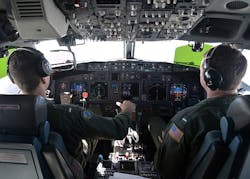Northrop Grumman to install electronic warfare (EW) and electro-optical missile-defense on P-8A jets
LAKEHURST, N.J. – Military avionics experts at Northrop Grumman Corp. will provide electronic warfare (EW) and missile-defense subsystems for the U.S. Navy P-8A Poseidon maritime patrol jet under terms of a $27.3 million contract announced last week.
Officials of the Naval Air Warfare Center Aircraft Division in Lakehurst, N.J., are asking the Northrop Grumman Mission Systems segment in Rolling Meadows, Ill., to integrate the AN/AAQ-24 large aircraft infrared countermeasures system (LAIRCM) and the ALQ-213 electronic warfare management system on P-8A production aircraft lots 9 and 10.
These aircraft will be for the Navy, as well as for the governments of Australia and the United Kingdom.
The ALQ-213, built by Terma North America Inc. in Arlington, Va., is a low-power electronic warfare (EW) management unit that uses no forced air cooling, has a dual-core PowerPC microprocessor and a large field programmable gate array (FPGA). The unit also has a Wind River VxWorks operating system. It offers a non-ITAR controller for a military aircraft survivability equipment (ASE) suite, which provides automatic threat reaction and decision support algorithms and on-board training for P-8A aircraft crews.
The Terma ALQ-213(V) has an expansion slot for drop-in of one special purpose circuit cards. The expansion slot provides a fast PCI express interface to the dual-core CPU and can be supported by a dedicated external connector, with minimal impact to the unit design.
Related: Electro-optical sensors key to missile defense
The electronic warfare management unit typically integrates several aircraft survivability equipment sensors and effectors via one or more MIL-STD-1553B data buses and discrete and serial interfaces. The electronic warfare management unit can integrate cockpit multi-function display and control units or provide graphical human interaction via terma’s advanced threat display.
The Northrop Grumman AN/AAQ-24(V) LAIRCM electro-optical missile warning sensor is designed to provide missile-warning capability to protect large military aircraft from infrared-guided, heat-seeking missiles -- particularly those from shoulder-fired launchers like the U.S.-made Stinger Block 2 and Russian-made SA-14 missiles.
The LAIRCM is a derivative of the AN/AAQ-24 Nemesis Directional IR CounterMeasure (DIRCM) system. It jams the incoming missile's seeker with a IR laser energy beam, and operates autonomously without intervention from the aircraft crew.
On this contract Northrop Grumman will do the work in Rolling Meadows, Ill., and should be finished by February 2021. For more information contact Northrop Grumman Mission Systems online at www.northropgrumman.com, or the Naval Air Warfare Center Aircraft Division-Lakehurst at www.navair.navy.mil/lakehurst.
Ready to make a purchase? Search the Military & Aerospace Electronics Buyer's Guide for companies, new products, press releases, and videos

